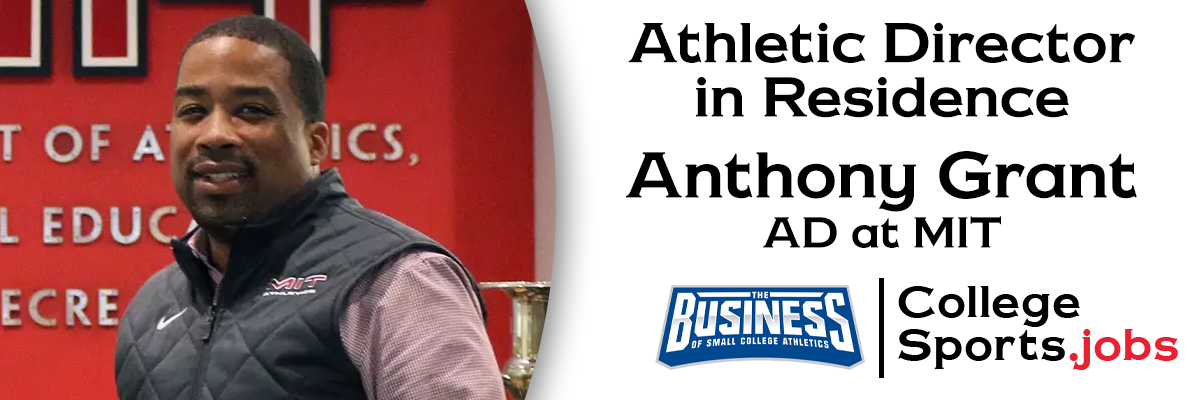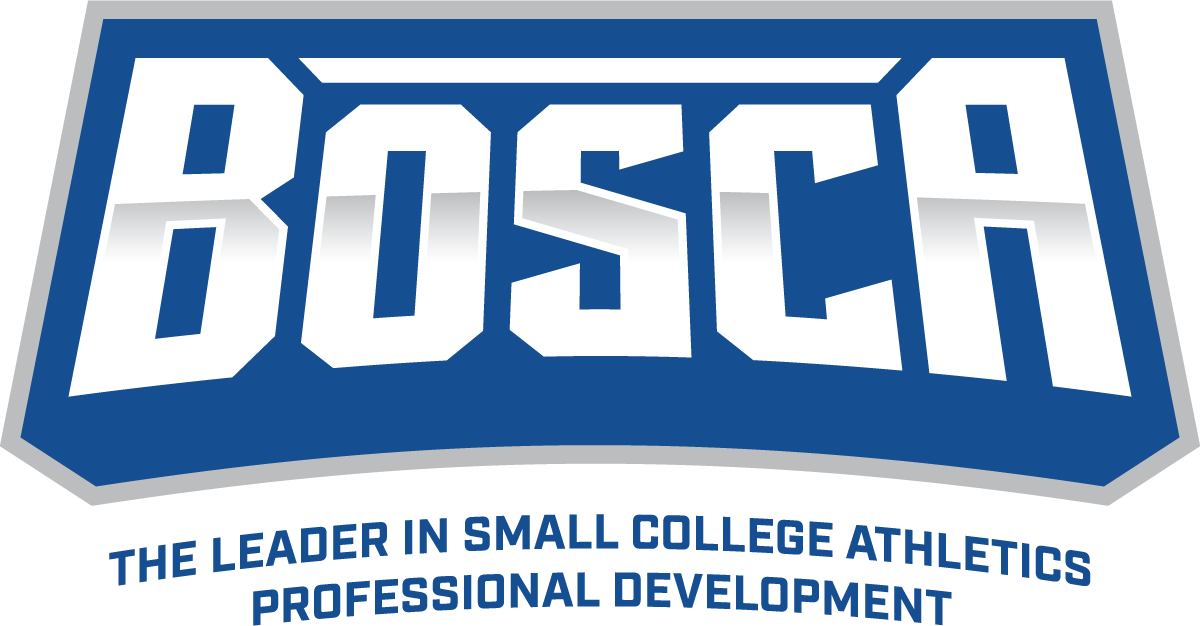AD in Residence: MIT AD G. Anthony Grant Ph.D.
MIT AD G. Anthony Grant dives into leading such a prestigious academic institution, fostering continued success, leadership challenges and more.

You direct a department that supports one of the most comprehensive Division III athletic programs in the country with 33 intercollegiate teams, in addition to overseeing recreation for an institution with an enrollment of over 11,000. As you enter your fourth full academic year leading the Engineers, how do you go about leading the organization and setting and achieving goals to move MIT forward?
MIT is a fascinating place and it’s personally gratifying for me to lead a department that has a significant impact on the student population at a world-renowned institution. In addition to sponsoring 33 intercollegiate athletic programs and a comprehensive recreation program, we also sponsor a wide range of club sport and intramural programs, as well as a robust Physical Education and Wellness curriculum, which is part of the General Institute Requirement. We are one of the few departments on campus that has a touchpoint with every student on campus. Every day I think about how we can position our department to fulfill our mission to more effectively meet the needs of our students and the broader MIT community, while also positioning our athletic programs for sustained success and the pursuit of excellence.
When you became the AD at MIT and MSU Denver before that, you succeeded ADs who had been there for well over a decade. How did you approach taking over for such respected, established leaders?
I have learned a great deal from both Joan McDermott (MSU Denver) and Julie Soriero (MIT). They are both transformational leaders that made long-lasting impacts at their respective institutions and on the national scale. They are both Hall of Fame athletic administrators that deserve all their impressive accolades. Fortunately, for me, they left behind departments with strong foundations that I could build upon. During the first few months at each institution, I was able to take the time to learn about the department and get to know the student-athletes, coaches, staff, alumni, and key campus constituents to truly assess what the needs of our programs were before implementing the direction for the department under my leadership and vision.
MIT has finished in the top 25 of the Division III LEARFIELD Directors' Cup every year since 2010-11, finishing inside the top 10 most years. What are a handful of things that seem to be playing a part in this success? How have you worked to foster continued success?
There is an expectation that we strive for excellence in everything that we do. Our success is not just defined by our wins and losses; it’s really defined by the investment that we make in our student-athletes to ensure they are receiving a high-quality and well-rounded experience during their time here at MIT. The success of our programs started with a commitment to elevating the athletic experience for our student-athletes to align with the academic experience that they were receiving in the classrooms and the labs. We have been able to recruit student-athletes who are not only gifted academically, but who are also talented athletes. MIT has a 4% acceptance rate. The admissions process for our student-athletes is the same as it is for the general student population, which presents a challenge in recruiting. However, we have committed and talented coaches and staff who work diligently to identify outstanding student-athletes who not only meet the academic profile of the institution, but who can also compete at a high level.
We are only as successful as our people. Over the years, we have been intentional in making investments in areas that will enhance the student-athlete experience and secure resources that will position our coaches and staff for sustained success in support of our student-athletes.
MIT is one of the most prestigious institutions in the world. Two questions: How have you gone about building relationships across campus? And how are you tapping into those resources on campus to benefit athletics?
It goes without saying that the academic enterprise clearly drives MIT, which makes developing relationships with faculty essential. In my role, I serve as Department Head, in addition to my role as Director of Athletics. Serving as a member of the faculty allows me to engage with faculty in other departments across campus and collaborate within the Institute governance structure. As I noted earlier, our department is one of the few departments that has a touchpoint with every student on campus. We also play a key role in supporting the Institute’s overall commitment to health and wellbeing throughout campus. Through our physical education and wellness curriculum, clubs and intramural offerings, and campus recreation resources, we can collaborate with faculty and other key offices on campus to create and secure innovative resources that not only benefit our intercollegiate athletics programs, but our general student population as well.
What is the biggest challenge your department is facing and how are you and your team thinking about how to solve it?
Our challenges are consistent with what most athletics departments are facing. We are monitoring the changing landscape of the NCAA and how these changes will impact Division III, particularly as it relates to NIL, monetization of DIII assets, conference realignment, changing transfer regulations and its impact on recruiting, in addition to how to meet the needs of our student-athletes more effectively, to name a few. There are numerous external factors impacting our enterprise and there are no easy answers to solve these problems. These are challenges that we track on a regular basis. My team and I continue to educate ourselves (as well as our internal and external constituents) on what is occurring across the broader landscape to develop strategies that will position our department to be able to respond and take proactive measures to address these challenges, when possible.
You’ve worked at the Division I, II and III levels, what are some of the nuances of Division III that you have learned to navigate in leadership?
I have developed an appreciation for my experiences in all three divisions. While MIT is a multi-divisional department competing primarily at the Division III level, the scope and scale of the department are comparable to many Division I athletics departments, with our crew programs competing in Division I but with a Division III philosophy. The philosophy at the Division III level is clear in its commitment to ensuring that a student-athlete’s activities are conducted as an integral part of their educational experience. At this level, there is more intentionality in fostering an environment that positions our student-athletes for success in competition, while also supporting their nonathletic pursuits. I have always had a holistic approach to enhancing the student-athlete experience, but ensuring that the athletic responsibilities for our student-athletes do not detract from their academic pursuits and involvement in other activities on campus is more of a point of emphasis at the Division III level.
As someone who has more than nine years of experience in the chair, what career advice would you give to aspiring ADs? And what would you prioritize early in your career if you were to start over?
The first piece of advice that I would provide anyone who aspires to become an AD is to be clear about their motivation for why they want to move into the “chair” and not waiver from their core values. It is your responsibility to set the direction and embed the culture within your respective departments to position your student-athletes, coaches, and staff to thrive. While being an AD is extremely rewarding, this is a position that also has its fair share of challenges, including navigating pressures both internally and externally. Often our decisions have a broader impact on the individuals within the respective programs we lead. Anyone who aspires to be an AD (or leader in any organization for that matter) needs to not only be clear about their motivation and core values but be able to use it as a guide to make decisions for the overall benefit of the department, even when it's difficult or unpopular.
Authenticity as a leader is extremely important. Develop a leadership style that is consistent with who you are as a person. Stay true to yourself. Be honest enough to admit your mistakes and hold yourself accountable, just as much (if not more) than the team you lead.
Pursue positions at institutions aligned with your core values and that have a shared vision for the success of the athletics department and commitment to the students we serve.
It is immensely important to have a team of mentors who you can share ideas with, talk through challenging situations with, and who can tell you when you are wrong. Leadership can be lonely at times and my mentors have been an invaluable support to me over the years.
Lastly, it is extremely easy to become consumed by the time demands and pressures associated with being an athletics director. In this position, you are constantly serving and pouring into others. It is important not to forget about taking time out for yourself and your family. I was not particularly good about that early in my career. I am being more intentional about doing a better job of establishing more of a balance when I can.

